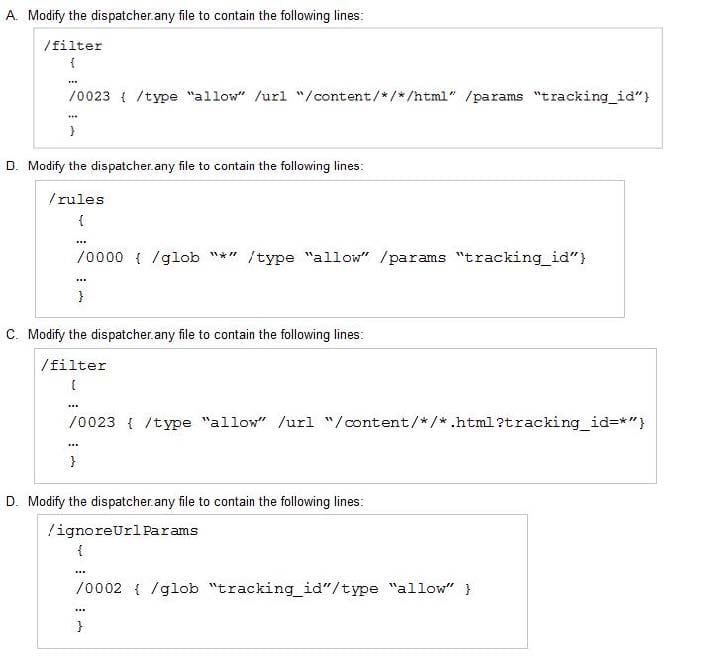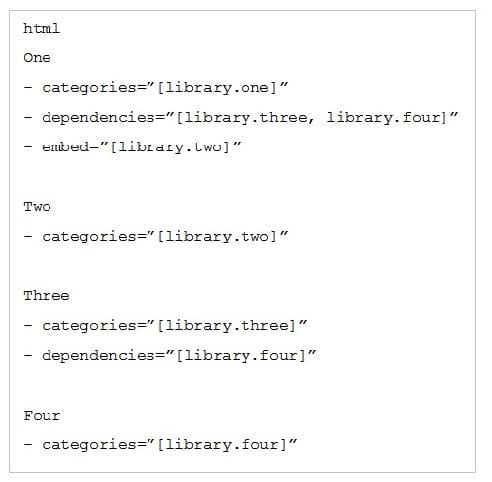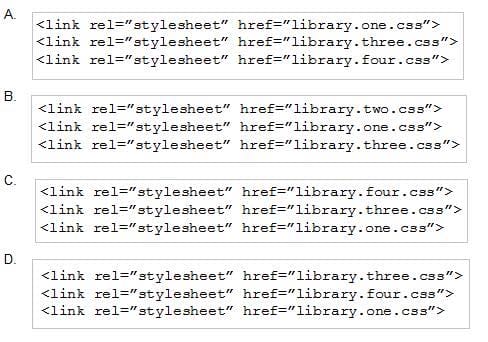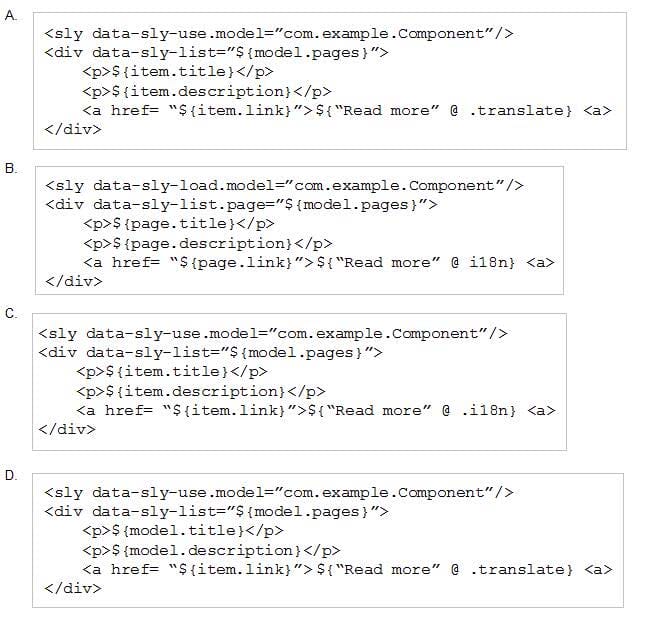Exam Details
Exam Code
:AD0-E103Exam Name
:Adobe Experience Manager DeveloperCertification
:Adobe CertificationsVendor
:AdobeTotal Questions
:92 Q&AsLast Updated
:Jun 26, 2025
Adobe Adobe Certifications AD0-E103 Questions & Answers
-
Question 81:
Which log file contains AEM application request and response entries?
A. response.log
B. request.log
C. history.log
D. audit.log
-
Question 82:
A developer identifies that some requests for the page /content/sampleproject/page.html take longer that other requests for the same page. Refer to the $DOCROOT/content/sampleproject directory below.

The dispatcher.log file contains the following lines:

How should the developer make sure that the page is always cached?

A. Option A
B. Option B
C. Option C
D. Option D
-
Question 83:
A developer creates a Sling Servlet. The Sling Servlet is bound to a path (/service/sling/sample). Refer to the resulting code below.

What should the developer do to make the servlet access controlled using the default ACLs?
A. Use @SlingServletResourceTypes instead of @SlingServletPaths.
B. Modify @SlingServletPaths(value = {"/bin/sling/sample" }).
C. Add @SlingServletName(servletName = "AccessControlServlet") annotation.
D. Add @SlingServletPrefix(value = "/apps") annotation.
-
Question 84:
A developer wants to extend AEM Core Components to create a custom Carousel Component. How should the developer extend the Core Components?
A. Make changes to the original component and assign a component group.
B. Use the sling:resourceSuperType property to point to the core component.
C. Use the sling:resourceType property to point to the core component.
D. Copy the Core Carousel component to /apps/
folder. -
Question 85:
A developer wants to change the log level for a custom API. Which OSGi configuration should the developer modify?
A. Apache Sling Logging Configuration
B. Apache Sling Log Tracker Service
C. Apache Sling Logging Writer Configuration
D. Adobe Granite Log Analysis Service
-
Question 86:
Refer to the following four Client Library Folders.

A developer uses the following:

What is the resulting HTML?

A. Option A
B. Option B
C. Option C
D. Option D
-
Question 87:
A developer is installing a content package with the package manager. The developer needs to restrict the approximate number of nodes in a batch that is saved to persistent storage in one transaction.
How should the developer modify the number of transient nodes to be triggered until automatic saving?
A. AEM instances automatically modify the number of transient nodes based on the load balancing.
B. Modify the export package manifest header and copy the content package to AEM installation folder.
C. Select the option MergePreserve for the Access Control Handling drop-down in the Install Package dialog-box.
D. Change the value of Save Threshold in the Install Package dialog-box.
-
Question 88:
A developer needs to implement a service component that should be manually configured by operations to react on operational circumstances. The service component should NOT be active by default. The service has the properties myservice.name (one string value) and myservice.stringValues (a list of the string values) to be configured. The developer needs to use OSGi Metatype annotations to make those properties configurable in the Apache Felix Web Console.
Which set of steps should the developer take to meet these requirements?
A. 1. For the class fields myserviceName and myserviceStringValues, add a @AttributeDefinition annotation each with names set to myservice.name and myservice.stringValues respectively.
2.
Use the @Component annotation with configurationFactory = true on the service component class.
3.
Use the @Service service component class.
4.
Use the activate method of the service component class to get the configuration annotation interface class injected.
B. 1. Create an annotation interface as inner class of the service component and annotate it with @ObjectClassDefinition.
2.
Apply @AttributeDefinition for the methods myservice.name and myservice.stringValues.
3.
Use the @Component annotation with configurationPolicy = ConfigurationPolicy.REQUIRE on the service component.
4.
Use the @Designate annotation to link the service component to the created configuration
annotation interface.
5.
Use the activate method of the service component class to get the configuration annotation interface class injected.
C. 1. Create an annotation interface as inner class of the service component and annotate it with @ObjectClassDefinition.
2.
Apply @AttributeDefinition for the methods myservice_name and myservice_stringValues.
3.
Use the @Component annotation with configurationPolicy = ConfigurationPolicy.REQUIRE on the service component.
4.
Use the @Designate annotation to link the service component to the created configuration
annotation interface.
5.
Use the activate method of the service component class to get the configuration annotation interface class injected.
D. 1. For the class fields myserviceName and myserviceStringValues, add a @Property annotation each with names set to myservice.name and myservice.stringValues respectively.
2.
Use the @Component annotation with configurationFactory = true on the service component class.
3.
Use the @Service service component class.
4.
The configuration is automatically injected into the field by the service component runtime.
-
Question 89:
A developer needs to create a banner component. This component shows an image across the full width of the page. A title is shown on top of the image. This text can be aligned to the left, middle, or right. The core components feature a teaser component which matches almost all requirements, but not all.
What is the most maintainable way for the developer to implement these requirements?
A. Use and configure the teaser core component.
B. Create a new custom component from scratch.
C. Overlay the teaser core component.
D. Inherit from the teaser core component.
-
Question 90:
A developer is creating a custom component that shows a list of pages. For each page, the following items
must be shown:
Title of the page
Description of the page
A button with fixed text “Read more” that must be translatable
All of the above fields must be wrapped in a
tag.The logic for obtaining the list of pages must be reusable for future components.
Which snippet should the developer use to meet these requirements?

A. Option A
B. Option B
C. Option C
D. Option D
Related Exams:
9A0-019
Adobe Photoshop 6.0 Product Proficiency9A0-042
Acrobat 7.0 Prowith Adobe LiveCycle Designer ACE Exam9A0-043
Adobe Illustrator CS 2 ACE9A0-044
Adobe Photoshop CS 2 ACE Exam9A0-045
Adobe InDesign CS 2 ACE Exam9A0-046
Adobe GoLive CS2 ACE Exam9A0-055
Adobe InDesign CS3 ACE Exam9A0-056
Adobe Dreamweaver CS3 ACE Exam9A0-057
Adobe Illustrator CS3 ACE Exam9A0-058
Adobe Flash CS3 ACE Exam
Tips on How to Prepare for the Exams
Nowadays, the certification exams become more and more important and required by more and more enterprises when applying for a job. But how to prepare for the exam effectively? How to prepare for the exam in a short time with less efforts? How to get a ideal result and how to find the most reliable resources? Here on Vcedump.com, you will find all the answers. Vcedump.com provide not only Adobe exam questions, answers and explanations but also complete assistance on your exam preparation and certification application. If you are confused on your AD0-E103 exam preparations and Adobe certification application, do not hesitate to visit our Vcedump.com to find your solutions here.